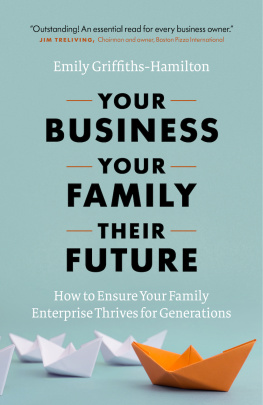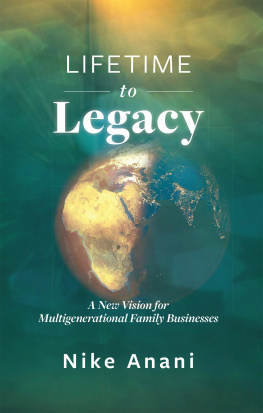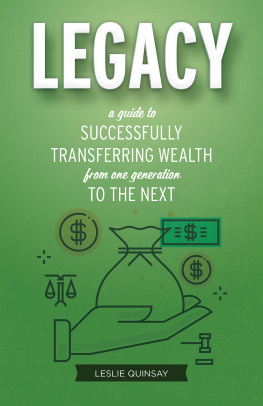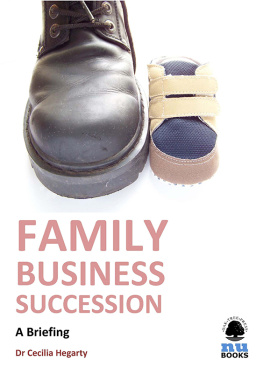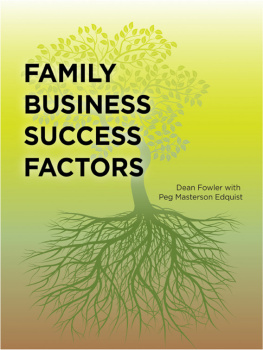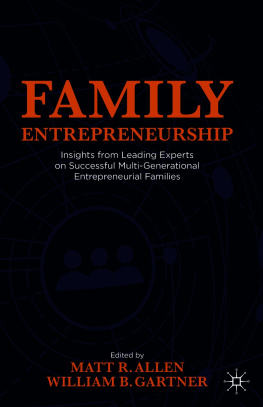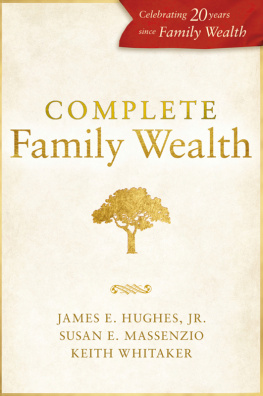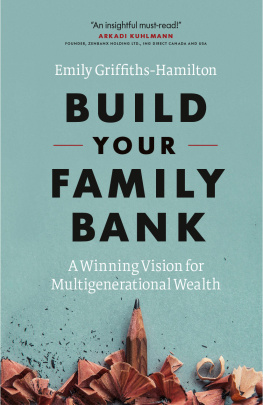I have known Emily and her family for decadesBoston Pizza was one of the first tenants in GM Place, the Vancouver arena that she and her partners financed, built and operated. Ive seen her build and lead a high-profile family enterprise, and then focus her considerable education, training and experience to help other family enterprises reach their goals.
There is value here for anyone involved with a private business of any kind, at any stage. This is a book youll want to keep around. In fact, this is a book Ill keep coming back to. What an exciting read!
Introduction:
Put Your Family on the Path to Success
T here is no institution more enduring than the family business. Family businesses predate multinational corporations, the Industrial Revolution, the Enlightenment and even the Roman Empire. According to the Family Firm Institute, family businessesbusinesses in which decision-making is influenced by a familyconstitute between 70% and 90% of GDP annually and create 50%80% of jobs in the majority of countries worldwide today. That makes family businesses economic powerhouses that drive local, national and global economies. For every high-profile family business like Ford, Walmart, The New York Times, Lavazza, Tata, Kikkoman, Taittinger and Samsung, there are thousands of lower-profile, private family-owned businesses making decisions about how to manage and grow their operations. In this book, Ill share my insights about what successful families know and how they leverage that knowledge to remain strong across multiple generations.
A vast body of knowledge has been generated by business scholars and researchers investigating how successful family enterprises remain robust across generations. My goal is to consolidate this information, giving you and your family a useful entry point for building a multigenerational family enterprise. Ill also share suggestions, tips and strategies based on the common patterns found within successful families.
To do this, Ive drawn on personal experience, extensive independent research and years of work as a family enterprise advisor, a family business advisory board member and a family meeting facilitator. Growing up, I had a ringside seat at the family business table of my visionary maternal grandfather, veterinarian Dr. William Ballard. During the Great Depression, my grandfather came up with what turned out to be a wildly popular formula for dog food and then, in a revolutionary move, canned it for easier distribution. As the youngest of his many grandchildren, I grew up with first-hand knowledge of the workings of the family business and the results of its transition of ownership.
My father was also a visionary business builder and leader. Alongside his highly respected career as a chartered accountant ( CA ) in public practice, he built a media and sports empire that ultimately spanned radio, television and satellite communications across Canada and the ownership of our communitys beloved National Hockey League team, the Vancouver Canucks. Although I was the youngest of four siblings, I had a front-row, fully participating family-member seat at the table. The insights I gained in the years that followed came from the perspective of being the only sibling in my family to obtain a professional designation, as a CA , and to work entirely independently of my family.
As a member of the third generation, I became a decision maker, a role entirely different from simply having a seat at the table. The ownership group I belonged towhich included one of my brothers, Arthur Griffiths, and John and Bruce McCawbought the Vancouver Canucks, financed the construction of a state-of-the-art arena in the city of Vancouver and bought the Vancouver Grizzlies, one of the first two National Basketball Association ( NBA ) franchises awarded in Canada. That was a wild, all-consuming roller coaster ride. At a certain point, I made the decision to sell my interest in the sports and entertainment holdings and to reformat our family enterprises financial assets into the financial markets and direct real estate holdings and build our Family Office. Now into its fourth generation, our family enterprise continues to evolve and flourish.
In the decades over which my career developed, I began to focus on the topic of how successful family enterprises thrive for generations. As a CA working with other families who, like my own, had used the traditional tax- and control-driven tools to deal with family enterprise transitions, resulting in complex family corporate structures that often included trusts and holdcos, and later, as a family enterprise advisor, I started to see that successful families shared a number of traits. However, in so much of the information flooding the market on the subject of successful multigenerational family enterprises, these traits seemed lost in a sea of unnecessary complications.
Heres one example. I receive regular emails from different sources on the latest research into family enterprises. A recent one caught my attention because of its vibrantly colored diagram: elongated oval shapes that overlapped and fanned out like the feathers on a peacock. Each tiny overlapping area was labeled with a different acronym: fifteen of them in total. Following the website link, I discovered this complex model existed to explain the role of governance in a family enterprise. I shared the link with a business owner who responded, Wow! I cant get my kids out of bed in the morning. How am I going to get through all this? In this book, you will discover that the work required to make your family enterprise thrive isnt complicated.
For instance, the topic of family business governance in family enterprises implies the need for a complex, rigid structure, but that runs contrary to the trait that has made most business builders successful: their ability to be adaptable and flexible. For that reason, I use the term family enterprise framework instead. Successful family enterprises know that its important to create a family enterprise framework thats both flexible and solid enough to allow for sound decisions to be made when there are many decision makers in later generations, which in turn allows your family enterprise to evolve and thrive for many generations to come.

